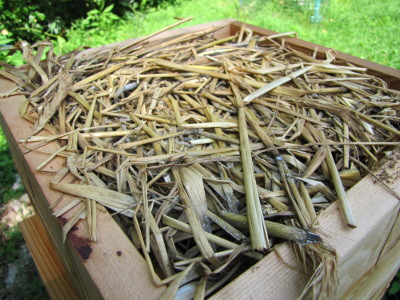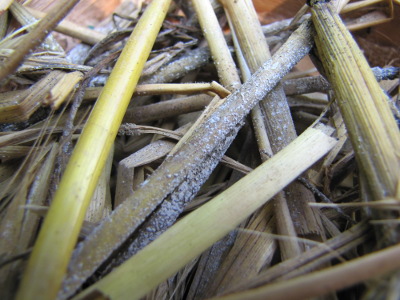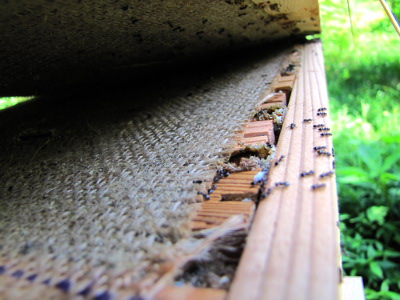
Problems in the Warre hive quilt
 Even though you're not
supposed to poke around in the Warre hive more than once a year, you
are allowed to take off the lid and quilt and observe the layer of
burlap that covers up the bees' living quarters. You're not
exposing the colony to the outdoors, so there's no need for protective
equipment or a smoker as long as you stand behind the hive (always a
good idea) rather than in the bees' flight path. Saturday as I
was lazing around the yard, I decided to pop the hood and take a look.
Even though you're not
supposed to poke around in the Warre hive more than once a year, you
are allowed to take off the lid and quilt and observe the layer of
burlap that covers up the bees' living quarters. You're not
exposing the colony to the outdoors, so there's no need for protective
equipment or a smoker as long as you stand behind the hive (always a
good idea) rather than in the bees' flight path. Saturday as I
was lazing around the yard, I decided to pop the hood and take a look.
 The first thing I noticed was
that the straw in my quilt box was starting to mold. The purpose
of the biomass in the quilt is to capture moisture coming out of the
hive while insulating the interior from climate extremes, so mold isn't
a very unusual occurrence there. However, discoloration generally
means its time to refresh the bedding, so I'll do that this week.
The first thing I noticed was
that the straw in my quilt box was starting to mold. The purpose
of the biomass in the quilt is to capture moisture coming out of the
hive while insulating the interior from climate extremes, so mold isn't
a very unusual occurrence there. However, discoloration generally
means its time to refresh the bedding, so I'll do that this week.
I carefully pried up the
quilt to take a look at the next layer down, and there I saw more of a
problem --- ants everywhere! A quick search of the internet
suggests that ants can be common in  Warre hives, and I see
why. The quilt creates a safe, mostly dry habitat that bees can't
get into to clean, but into which ants can often squeeze.
Presumably, the ants also pop down through the burlap between the quilt
and the hive and help themselves to the honey stores.
Warre hives, and I see
why. The quilt creates a safe, mostly dry habitat that bees can't
get into to clean, but into which ants can often squeeze.
Presumably, the ants also pop down through the burlap between the quilt
and the hive and help themselves to the honey stores.
Some beekeepers make a
wooden stand for their hive and place the feet in containers of water
or oil to keep the ants from climbing up. I may have to resort to
that, although I did see a skink in the quilt box that might have been
busy eating up the problematic ants. I'm curious to hear if
anyone else has found ants in their Warre hive quilt --- what did you
do about it?
Want more in-depth information? Browse through our books.
Or explore more posts by date or by subject.
About us: Anna Hess and Mark Hamilton spent over a decade living self-sufficiently in the mountains of Virginia before moving north to start over from scratch in the foothills of Ohio. They've experimented with permaculture, no-till gardening, trailersteading, home-based microbusinesses and much more, writing about their adventures in both blogs and books.
Want to be notified when new comments are posted on this page? Click on the RSS button after you add a comment to subscribe to the comment feed, or simply check the box beside "email replies to me" while writing your comment.

Faith --- It might need to be oil to keep the legs from rotting, but that does seem like a good solution.
Roland --- I'm not sure if mineral wool would give the same effect. Part of the purpose is to soak up the water, not just let it pass through. Mark's idea was to use something absorbent and to have two quilts, swapping them off every month so one could dry while the other soaked up moisture. Low tech, but might get closer to the intended purpose without molding....
I have had great success repelling ants from my hives using plain-old ground cinnamon around the edges of my top cover.... the ants find it very unpleasant; bees don't come into contact with it, and its completely nontoxic. One "sprinkling" has lasted an entire year for me, since the cinnamon stays relatively dry and undisturbed under my top cover.
Best of luck!
The cinnamon sounds like a good idea - I haven't heard that anywhere else before (and its been too wet here this summer to be able to test it). The mineral wool and teflon options kind of go against the sustainable approach which underpins the Warre approach however.
Anna, its interesting to see that your top bar cloth doesn't completely cover your top bars is this a design modification of your own?
I've found ants many times under the cover of my top bar hives, and after some initial attempts at using cinnamon and then Vaseline on the legs of the hive, I decided to leave them alone. I have not seen any sign that they are actually infesting the hives themselves, they are only present in areas the bees can't reach.
I've wondered if their presence might actually deter other more problematic parasites.
I only have 2 hives and have just been at it for a little over a year, so I'm far from an expert. But you might consider the ants just part of the natural ecosystem. As long as they aren't causing problems inside the hive proper, I don't worry about them.
Roland --- That does sound pretty good....
Laurence --- I'm okay with something like teflon tape if you only have to apply it once, even if it's not entirely sustainable.
The "design modification" is really a flaw. We bought the hive, and it came with the piece of burlap you see there, but the piece wasn't quite big enough. I thought it wasn't going to be a problem, but now I think it is --- when I took off the quilt to knock the ants out (they were actually nesting inside the straw), bees came up through the hole and got agitated. I'm now thinking that it might be good to attach the fabric there to a thin wooden frame to totally prevent that problem without allowing fabric to stick out and bring damp into the hive.
Jason --- That's a good question --- whether the ants are actually going in to steal honey, or just taking advantage of a dry place to live. I'll have to look carefully inside when the time comes to go through and assess honey stores this fall. I'm all for living and letting live if the ants aren't causing trouble.
Hi, as regards the Top Bar cloth, I use the technique suggested by the Abbe and use a piece of hessian/burlap sacking which has been painted on either side with a flour and water paste.You cut the cloth to be a bit larger than the dimensions of the body box to begin with. Once the paste has dried the cloth becomes stiff and you can cut it with scissors to the exact dimensions you need. Once its on the hive there shouldn't be any problems with water seeping in as the sides of the roof should prevent the edges of the cloth from being exposed to the weather. Apparently the paste stops the bees chewing-through the cloth but it still allows the hive to breathe into the quilt. Here's a link...http://www.dheaf.plus.com/warrebeekeeping/preparing_hessian.htm